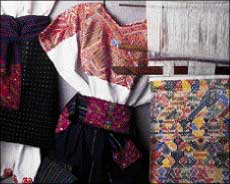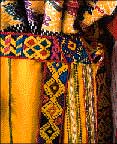By Lisa Ann Jackson
Glass cases don the rich hues of India, the bright colors of Guatemala, and the earthy tones of Fiji. Fabrics woven of wool or pounded of bark speak to visitors at BYU’s Museum of Peoples and Cultures, telling them of tradition, heritage, and culture.
The current exhibition, Common Threads: Weaving Cultural Identity, was given voice by a group of students receiving training in a professional setting. It is the sixth exhibition in six years to be curated by students, and the Museum of Peoples and Cultures is the only BYU museum that relies almost exclusively on the talents of student curators.

These vibrant textiles demonstrate the skill of today’s Mayan weavers and often reveal a weaver’s home region. This Guatemalan case and other displays in the Common Threads exhibition were curated by students.
“It’s a really good program because students get a lot of individualized attention and some wonderful hands-on experience,” says Heather Seferovich, coordinator of programs at the museum.
The program began in 1992 as a one-semester undergraduate-level class that culminated in a small exhibition. It has since grown into a graduate-level series that lasts from fall semester to spring term, by the end of which students have filled the museum’s two galleries with exhibitions they created.
The museum staff trains students in all aspects of producing an exhibition, and the students become completely responsible for the galleries. They attend to every detail of the process–writing proposals for grant money, securing objects on loan from other museums, researching artifacts and cultures, writing labels, controlling humidity in the display cases, and even cvering light bulbs with UV-blocking sheaths.
“Usually you have to be a professional to get the kind of experience that we got,” says Amy Anderson, a recent graduate in archeology who was responsible for the gallery on Peruvian textiles in Common Threads.
That’s just what Marti Lu Allen, director of the Museum of Peoples and Cultures, intends for her students–a professional experience. While BYU does not currently offer a degree or certificate program in museum studies, the course work at the Museum of Peoples and Cultures, taught through the Anthropology Department, provides training that is generally unavailable, even through museum studies programs. Most such programs focus on theory, Allen says, and do not provide the extensive hands-on training that students receive at BYU.
Joan White, the student curator for the Common Threads Guatemalan case, came from such a program. She has a master’s degree in museum studies, but after volunteering at the Museum of Peoples and Cultures, she decided to take the classes.
 “Many of the things I did while getting my degree were just theory and exercises,” says White. The practical experience is really valuable.”
“Many of the things I did while getting my degree were just theory and exercises,” says White. The practical experience is really valuable.”
The courses–team taught by Allen, Seferovich, and Shane A. Baker, the museum’s collections curator–train students to effectively handle the creative challenges and logistical demands of museum work.
“The students see that we have limited money and staff to do what we hope to do, but they come up with a way,” says Allen. “When they go out into the real world of museums, they are going to have the same kinds of problems. And if they can lick ours, they can probably go anywhere and overcome those challenges.”
Students became heavily involved with the exhibits at the Museum of Peoples and Cultures shortly after Allen arrived at BYU in 1991. While the museum has been a fixture at BYU for more than four decades, it has received limited attention outside the Anthropology Department. When Allen joined the department as an adjunct assistant professor and a museum administrator, she was the museum’s only full-time staff member.
The exhibits on display at the time had been up for over a decade.
“When I first got here I thought we were extremely hindered because we were so small and we had no programs and no staff and such a bad location,” says Allen. “But we turned these disadvantages into advantages.”
Training students to create exhibits is an advantage for both the students and the museum: Students are better prepared to go on to graduate work in museum studies or directly into professional museum employment, and the museum has additional human resources. “The beauty of this program is that these students get marketable professional experience and the museum gets a surrogate staff, and we all have a great time,” Allen says.







